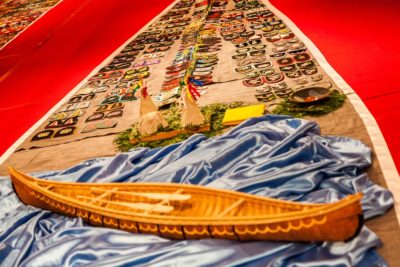FASS Blog – Walking With Our Sisters and Other Journeys by Sandra Dyck (Director of the Carleton University Art Gallery)

Over the course of three weeks, beginning on September 25th, 2015, Carleton University Art Gallery, in partnership with Gallery 101, hosted Walking With Our Sisters (WWOS), a commemorative installation honouring Missing and Murdered Indigenous Women, Girls, and Two-Spirit people of Canada and the United States. They are sisters, mothers, aunties, daughters, cousins, wives, grandmothers, and partners. They are not forgotten.


Many members of the local Indigenous community and Ottawa organizing committee formally welcomed the bundle—the contents of the Walking With Our Sisters installation—in a ceremony at Minwaashin Lodge in early September. On a beautiful day later that month, Pinock Smith, an Algonquin master canoe-maker from Kitigan Zibi, arrived on campus to move Carleton University’s tipi to the lawn between the St. Patrick’s Building and Russell House. Pinock and his crew deftly set up the tipi, wrapping the canvas exterior around the interior framework of long, lean poles of black spruce, and before leaving, laying down fresh cedar boughs on the grass inside. While I stood watching the set-up, a stranger approached to offer a gift of sacred medicines—sage, tobacco, cedar, and sweetgrass—wrapped in red cloth. I was surprised and touched, but as I came to understand, Walking With Our Sisters is founded on countless such acts of generosity and kindness.
The first day of installation began with a sunrise ceremony, held in the tipi on a dark, chilly Monday. It was led by the Cree Elder Thomas Louttit, one of many local Elders who guided the organizing committee and volunteered onsite. A small sacred fire burned in the center of the tipi, as it would every day during WWOS. At the ceremony’s conclusion we emerged to the pale, pastel light of early morning. The tipi became a cherished place where visitors gathered around the fire, listening intently as Thomas and his fellow Firekeepers generously shared their stories, their knowledge, and always, their humour.

Many volunteers worked together for four days to realize the bundle’s installation. They laid the floor with neat rows of cedar boughs over which huge swaths of brilliant red fabric were taped down, demarcating the lodge. On the second day, they opened the boxes holding the installation’s heart—more than 1800 pairs of moccasin vamps created by people across North America, who responded in overwhelming numbers to a public call issued by the project’s founder, the Mètis artist Christi Belcourt. Pinock returned on the third day to place a five-foot birchbark canoe within the larger, canoe-shaped configuration of vamps at the centre of the lodge and to hang a bower of intertwined red alder saplings at its threshold.

Most of the vamps were arrayed on the floor in precise rows around the gallery’s perimeter, beginning with a group of blue vamps sent from Vancouver’s Downtown Eastside, in honour of the neighbourhood’s long history of advocacy for the rights of Indigenous women. From the floor the vamps bloomed forth in an ineffable profusion of materials, colours, symbols, and images. The vamps powerfully, and with a protean emotional force and energy, evoked the spirit of the women whose lives they honour. As Christi Belcourt told President Roseann Runte, this collective honouring is, for her, the vital purpose of Walking With Our Sisters.
The WWOS opening ceremony saw the gallery radically transformed into a space for ceremony. A live audio broadcast brought the afternoon’s events to the overflow tents set up outdoors, where Thomas Louttit led a pipe ceremony. Inside, the traditional Cree healer and Elder Juliana Matoush Snowboy oversaw a ceremony for family members. Several rose to speak aloud their grief and anguish, to bear witness to their loved one, and to have the vamps they had created formally feasted in to the bundle. One family drove ten hours, from Oujé-Bougoumou, to participate; for another, it was the first time they had spoken in public about their pain. It was a deeply moving event, marked by courageous acts of truth-telling.

Over the course of the three extraordinary weeks that followed, nearly 6000 people visited Walking With Our Sisters, including more than 1500 Carleton students. Each visitor removed their shoes, was greeted and smudged by an Elder or Helper, and took a tobacco tie in hand before entering the lodge to walk beside the vamps. WWOS created an inclusive public space in which these journeys could occur. It created countless opportunities—in the gallery, in the tipi, and in the classroom—for the forging of relationships, the creation of dialogue, and the sharing of knowledge. Most importantly, it enabled diverse peoples to come together to honour, to remember, and to raise awareness of Missing and Murdered Indigenous Women, Girls, and Two-Spirit people.



On the cold October day we took the tipi down, I saw on its inner walls the beautiful residue of a month’s worth of smoke from the sacred fire that had burned within. It symbolized, for me, the innumerable collective and cumulative acts of honouring enabled by Walking With Our Sisters, which opened our minds, our hearts, and all our senses. As Paul Allaire, a Métis Firekeeper who volunteered many hours in the tipi, said one day, sometimes the longest journey a human being can take is from their head to their heart.
Sandra Dyck
Director
Carleton University Art Gallery
CUAG thanks Gallery 101, the Elders, Helpers, and Firekeepers, the Walking With Our Sisters national and local organizing committees, and the many other volunteers who embraced WWOS and made possible its presentation in Ottawa.
Walking With Our Sisters Ottawa was recently honoured by the Canadian Museums Association with an “Award of Outstanding Achievement in Exhibitions – Cultural Heritage” and an “Award for Outstanding Achievement.”